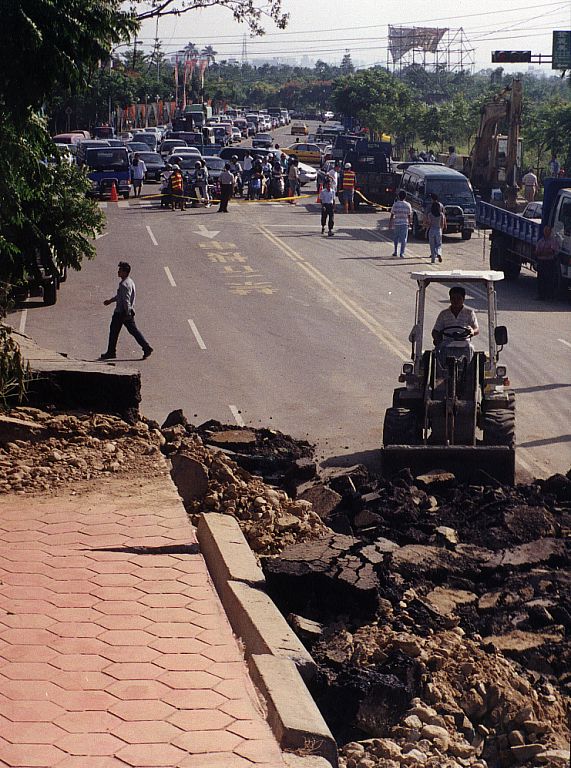by Brian Hioe
語言:
English
Photo Credit: 玄史生/WikiCommons/CC BY 3.0
A RECENT INCIDENT in Dazhi, Taipei raises questions about corporate negligence in the construction industry.
Specifically, 197 households consisting of 367 people in Dazhi had to be evacuated last week after several apartment buildings began tilting. It is thought that this was due to nearby construction by the Kee Tai Properties Company.
Some buildings tilted, while reportedly other buildings have already collapsed, and local residents were forced to evacuate without their belongings. In a video that went viral, a building can be seen sinking one story into the ground.
Video of the building sinking into the ground
The evacuated residents have since been put up in hotels, with the assistance of the city government. The area with the tilted buildings has been cordoned off by the police, with police patrols stepped up to prevent residents’ belongings from being stolen, The Taipei city government has distributed 6,000 NT to each resident as consolation money. Taipei mayor Chiang Wan-an has also stated that the city will provide legal consultation to local residents.
A nearby school, the Dominican International School, was closed due to the danger. The school is set to reopen, with local residents expected to be allowed to return to their homes after stabilization work by the city government.
Local residents had reported finding cracks in their walls in April and May, which was thought to be a result of the construction. Nevertheless, Kee Tai brought in outside experts to validate their claims that construction was safe. This was why construction continued. There have since been allegations of similar practices at other Kee Tai projects since the incident.
Affected residents have suggested that they might take legal action against Kee Tai by forming a self-help organization. In Taiwan, self-help organizations are frequently organized by local residents to pursue justice from development projects and the like, in the absence of a formal legal entity.
For its part, Kee Tai has pledged to take full responsibility and cooperate with investigations, with work at all of the company’s construction sites suspended. The company has pledged to provide all of the victims with 50,000 NT. There have been some fears about the company potentially filing for bankruptcy to evade legal responsibility.
It is not impossible that the cracks are due to typhoons, earthquakes, or similar natural disasters. But to this extent, preliminary assessments of the disaster by the city government suggest that excavation had taken place up to three stories underground without completion of the necessary foundation work for this to proceed safely. Experts have stated that the risk of ground liquefaction from construction should have been taken into account, given the presence of soft soil on the construction site, which is near an area located close to the Keelung River before its straightening.
Taiwan’s most famous incident of a building collapse in recent memory was the collapse of the sixteen-story Weiguan Jinlong in 2016 after an earthquake. Over 120 were trapped in the wreckage of the building. The incident went viral internationally because the collapsed building structure resembled an accordion and most of the casualties from the earthquake were in the structure.
In the aftermath of the incident, it was found that the construction company responsible for building the Weiguan Jinlong building had cut corners in the process of its construction. In particular, large cooking oil barrels were found in the materials of the building, as a cheaper substitute for safer materials. Subsequently, Weiguan Construction Company chair Lin Ming-hui was detained by authorities.
 Damage from the 1999 Nantou earthquake. Photo credit: Aaron Siirila/WikiCommons/CC BY-SA 2.5
Damage from the 1999 Nantou earthquake. Photo credit: Aaron Siirila/WikiCommons/CC BY-SA 2.5
This would not be the first such incident either. One saw similarly in the aftermath of the 1999 Nantou earthquake that killed 2,315, this being the second deadliest earthquake in recorded Taiwanese history. After the 1999 Nantou earthquake, cooking oil barrels were also found to have been used as materials in the collapsed buildings.
Cost-cutting at the expense of safety or cost-cutting to meet construction deadlines has frequently been found to have been a cause of deadly disasters in Taiwan, then. It is to be seen whether this will also prove to be the case with the building collapse in Taipei this time, though it is more common for such issues to be seen outside of Taiwan’s capital.
But issues of cost-cutting may be endemic in this regard. Cost-cutting at the expense of safety has been seen as the cause of everything from deaths of migrant workers in factories, who are not provided with the proper safety equipment, to transportation accidents that occur because construction sites near rail systems cut safety measures in order to rush and meet deadlines, cut costs, or similar reasons. Even if the building collapse this time did not lead to any fatalities, this can have very real and permanent consequences.

